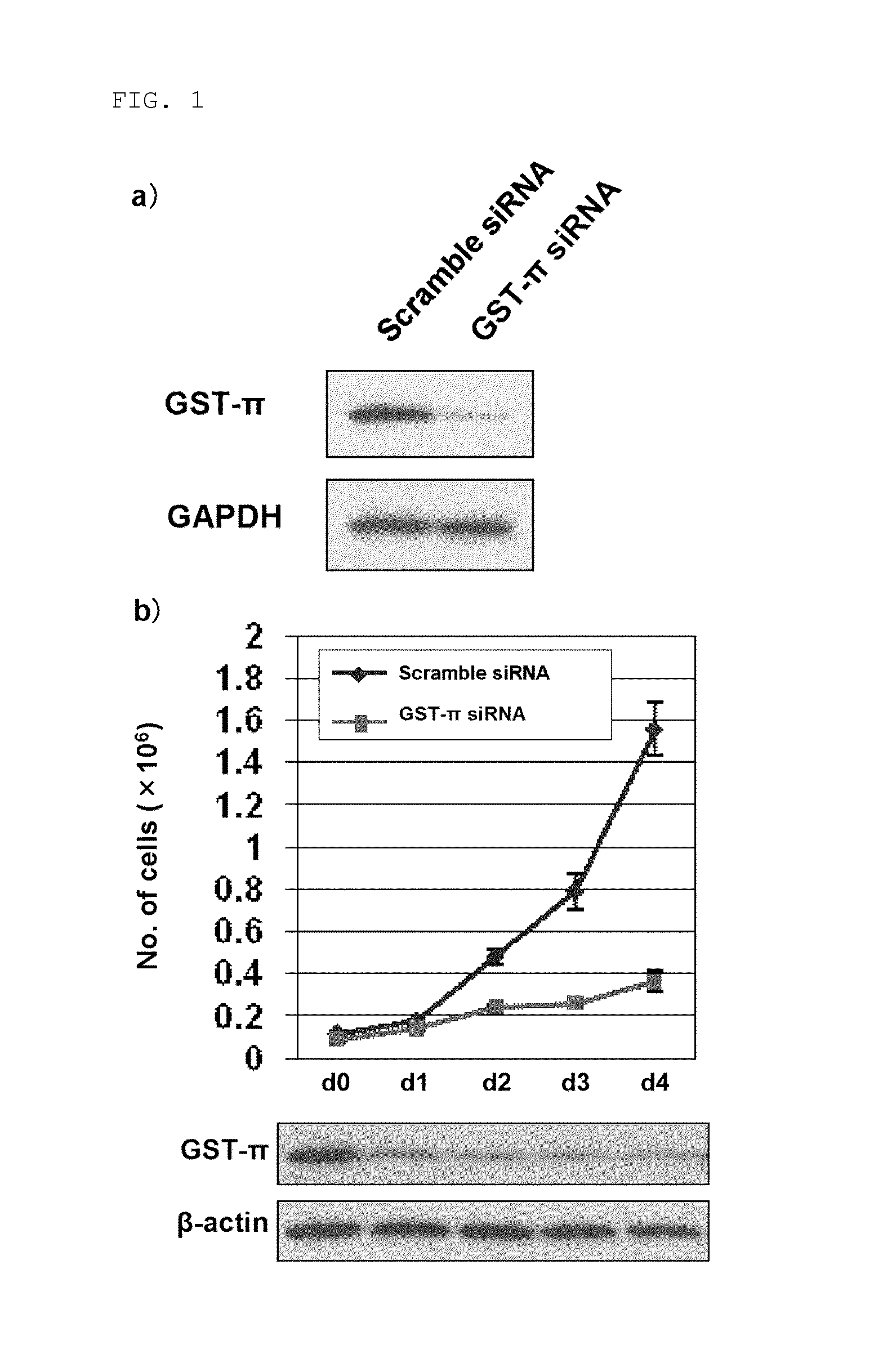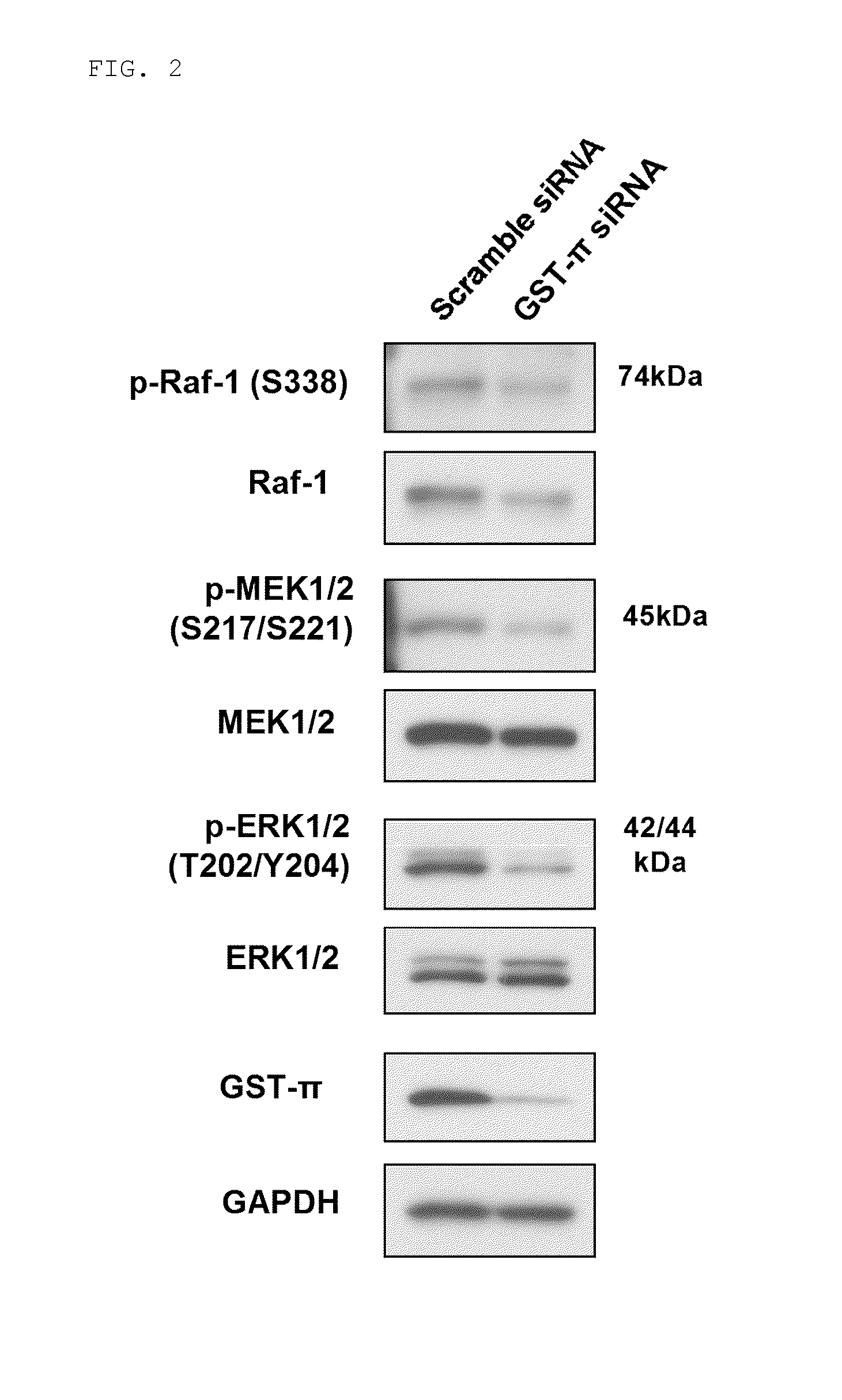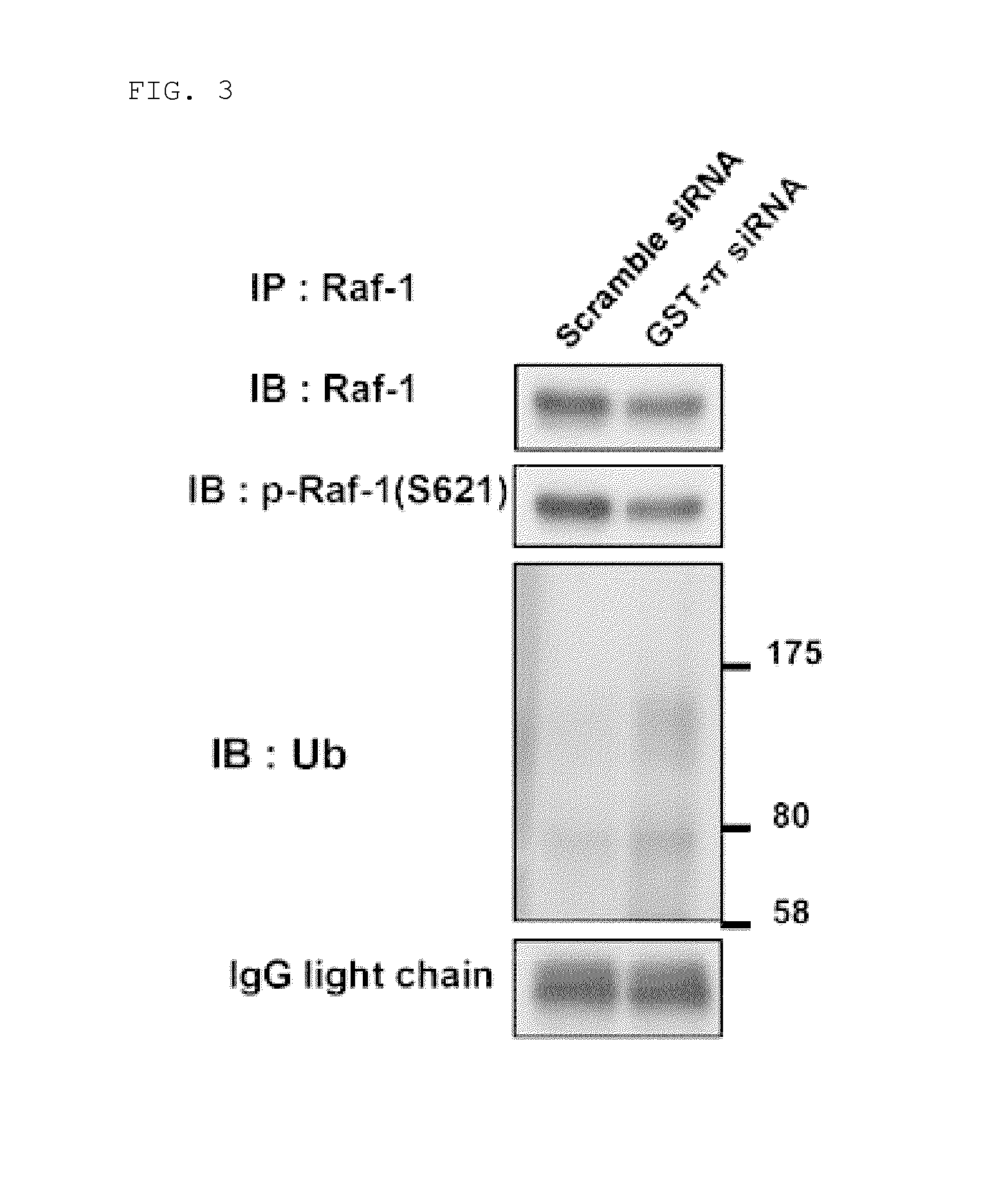Apoptosis-inducing agent
a technology of apoptosis and apoptosis, which is applied in the direction of transferases, peptide/protein ingredients, drug compositions, etc., can solve the problems of abnormal cell proliferation accompanied by side effects such as hair loss, gastrointestinal dysfunction, or bone marrow suppression, so as to reduce side effects, inhibit cancer from progressing, and high efficacy as a pharmaceutical composition
- Summary
- Abstract
- Description
- Claims
- Application Information
AI Technical Summary
Benefits of technology
Problems solved by technology
Method used
Image
Examples
example 1
Effect of GST-π Knockout on RAS / Raf / MAPK Signal Cascade
(1) Cell Culturing
[0129]K-RAS mutation-positive colon carcinoma cell line M7609 was cultured in 10% fetal bovine serum (FBS)-containing RPMI-1640 medium at 37° C. under an atmosphere containing 5% CO2. Furthermore, 100 U / mL penicillin and 100 μg / mL streptomycin were added as antibiotics to the medium.
(2) Transfection of GST-π siRNA
[0130]On the day before transfection, M7609 cells were plated on a 100 mm plastic tissue culture dish using 10% FBS-containing RPMI-1640 medium containing no antibiotic so as to give 1×106 cells / 10 mL. 600 pmol of GST-π siRNA (SEQ ID No: 1: GGGAGGCAAGACCUUCAUUTT, siRNA ID#2385, Ambion) was added to 1 mL of Opti-MEM I Reduced Serum Medium (GIBCO) and mixed gently. Subsequently, 35 μL of Lipofectamine RNAiMAX (Invitrogen) was diluted in 1 mL of Opti-MEM I Reduced Serum Medium and mixed gently. The diluted GST-π siRNA and the diluted Lipofectamine RNAiMAX were combined and gently mixed, and then incubated...
example 2
Effect of GST-π Knockout on Ubiquitination
(1) Effect of GST-π Knockdown on Ubiquitination of Raf-1
[0134]Culturing of M7609 cells and transfection with GST-π siRNA were carried out in accordance with the procedures of Example 1 (1) and (2).
[0135]In the same way as for Example 1 (3), on the 2nd day after siRNA transfection culturing was carried out for 16 hours in a serum-free medium, and a cell extract was collected. The cell extract thus obtained was subjected to quantitative protein analysis using a Micro BCA Protein Assay Kit (Scramble siRNA: 8.88 μg / μL, GST-π siRNA: 7.18 μg / mL). 0.5 μg of the cell extract was mixed with anti-Raf-1 antibody conjugated to Dynabeads Protein G (Invitrogen), incubation was carried out at 4° C. for 2 hours while gently mixing in a shaker to thus isolate Raf-1 protein, and then a western blot analysis was carried out in the same way as for Example 1 (3) using an anti-ubiquitin antibody (Santa Cruz). Phosphorylation modification of Ser621, which is invol...
example 3
Analysis of Induction of Autophagy and Apoptosis by GST-π Knockdown
(1) Analysis of Induction of Autophagy by Immunofluorescence Staining
[0139]Induction of autophagy by GST-π knockdown was analyzed by immunofluorescence staining with LC3, which is an autophagy-specific marker protein. GST-π knockdown cells obtained by the procedure of Example 1 (2) were plated on a cover slip placed in a 35 mm plastic tissue culture dish so as to give 1×105 cells / 2 mL. After the medium was aspirated, 4% paraformaldehyde in PBS was added, and incubation was carried out at room temperature for 10 min., thus fixing the cells. Permeabilization of the cells was carried out using 0.5% Triton X-100 in PBS on ice for 5 min. After washing with cold PBS for 10 min., a reaction with anti-LC3B antibody (Invitrogen) diluted with 1% BSA containing PBS was carried out within a humidity chamber at 37° C. for 1 hour. A secondary antibody reaction was carried out using Alexa Fluor488-labeled rabbit antibody (Invitroge...
PUM
| Property | Measurement | Unit |
|---|---|---|
| Composition | aaaaa | aaaaa |
| Cell proliferation rate | aaaaa | aaaaa |
Abstract
Description
Claims
Application Information
 Login to View More
Login to View More - R&D
- Intellectual Property
- Life Sciences
- Materials
- Tech Scout
- Unparalleled Data Quality
- Higher Quality Content
- 60% Fewer Hallucinations
Browse by: Latest US Patents, China's latest patents, Technical Efficacy Thesaurus, Application Domain, Technology Topic, Popular Technical Reports.
© 2025 PatSnap. All rights reserved.Legal|Privacy policy|Modern Slavery Act Transparency Statement|Sitemap|About US| Contact US: help@patsnap.com



